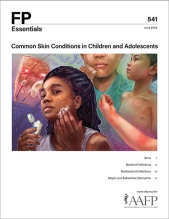
This clinical content conforms to AAFP criteria for CME.
Acne is a chronic, recurrent inflammatory condition of the pilosebaceous unit. It affects approximately 85% of adolescents and creates significant psychosocial and financial burdens. The pathogenesis involves altered follicular growth and differentiation, microbial colonization with Cutibacterium acnes, increased sebum production influenced by androgen levels, and inflammation. Evidence-based risk factors include family history and body mass index. Diagnosis of acne is clinical, according to patient age and acne morphology and severity. Setting treatment expectations is an important aspect of management. For mild acne, benzoyl peroxide is an effective first-line drug as monotherapy or in combination with a topical retinoid and/or topical antibiotic. Oral tetracyclines are first-line drugs as part of a multipart treatment regimen for moderate to severe acne for patients older than 8 years. Oral isotretinoin is the first-line drug for moderate to severe inflammatory acne. Because of its teratogenic effects, its prescribing is monitored through the iPLEDGE Risk Evaluation and Mitigation Strategy (REMS) program. Prescribing oral or topical antibiotics as monotherapy for acne is not recommended, as this may increase microbial resistance. Combined oral contraceptives and spironolactone are used as adjunctive therapies in female adolescents. Patients with skin of color, pregnant patients, and transgender or gender diverse patients warrant special considerations in acne management.
Subscribe
From $350- Immediate, unlimited access to FP Essentials content
- 60 CME credits/year
- AAFP app access
- Print delivery available
Edition Access
$44- Immediate, unlimited access to this edition's content
- 5 CME credits
- AAFP app access
- Print delivery available
